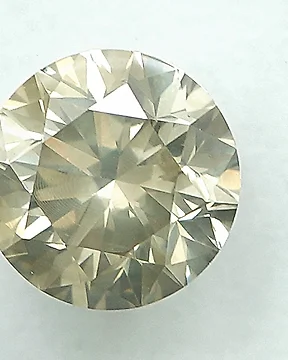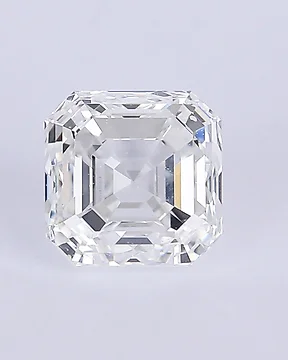Diamonds
1427 objects
Questions? Our Diamonds experts have answers
As the name implies, lab grown diamonds (also known as lab created, man-made, synthetic, cultured, or engineered diamonds) are formed in a laboratory. They are created using sophisticated technological processes that imitate the natural diamond-creation process.
Like natural diamonds, lab grown diamonds have similar physical and chemical properties. In fact, even professional gemologists cannot distinguish the difference between natural and mined diamonds. The two diamonds can only be differentiated using specialized laboratory equipment (so do not believe jewelers who tell you they can spot the difference between the two).
Similarly, like mined diamonds, lab grown diamonds are graded using the 4C grading system developed by the Gemological Institute of America (GIA), which evaluates diamond quality based on color, clarity, cut, and carat weight.
So, why should buyers choose lab created diamonds over their natural counterparts? First, lab grown diamonds are environmentally friendly. Unlike natural diamond mining that destroys land and produces high carbon emissions, lab grown diamond production does not harm the environment.
Second, lab grown diamonds are ethical. It's possible to trace their source, so there's no risk of buying a ''blood diamond.''
Finally, lab created diamonds are generally more affordable than natural diamonds. Synthetic diamonds cost nearly 90% less than their natural counterparts. For instance, while a natural, high-quality 2-carat diamond costs roughly $13,000 to $14,000, a similar man-made diamond costs about $1,000.
Natural diamonds are formed about 150 to 200 kilometers below the earth's surface (in what's known as the mantle). At these depths, temperatures range between 900 to 1300 degrees celsius and pressures range between 45 to 60 kilobars (approximately 50,000 times the pressure of the earth's surface). Under these conditions, carbon atoms join to create diamonds, a process that can span thousands of millenia. This process takes place in special volcanoes called kimberlites.
However, to get to the earth's surface from deep below it, diamonds must be ''pushed up.'' This occurs when the earth's mantle melts into magma, forcing the magma to rise quickly to the surface. This process triggers volcanic eruptions, transporting diamonds to the earth's surface via kimberlite pipes at tremendous speeds. These kimberlite pipes are the most significant source of natural diamonds, accounting for nearly 98% of all natural diamonds.
Besides being formed this way, some natural diamonds have also been brought to the earth's surface due to meteorite impacts and tectonic plate movements. However, unlike diamonds formed deep below the earth's surface, these diamonds are typically small and of low quality.
Apart from being formed naturally, diamonds can also be created artificially in laboratories. These diamonds created in labs (commonly known as lab grown diamonds) are formed using a process that simulates the one used to form natural diamonds.
Diamonds are made in one of two ways. Either naturally or artificially in a lab-controlled environment that simulates the natural process in a shorter period.
Natural diamonds are made from carbon trapped deep below the earth's surface (the mantle). This carbon is subjected to intense heat, about 1,200 degrees Celsius (2,200 Fahrenheit), and a high pressure of about 725,000 pounds per square inch (5,000 megapascals). After undergoing this process, diamonds are made.
However, since these diamonds are deep below the earth's surface, they need to be delivered to the surface. This occurs through volcanic eruptions that transport the diamonds up through the mantle to the earth's surface.
On the other hand, lab grown or synthetic diamonds are made using one of two methods: the High Pressure High Temperature (HPHT) Method or the Chemical Vapor Deposition (CVD) method.
With the HPHT method, a small fragment of a natural diamond, known as a ''seed'' that's enclosed in pure carbon is placed into a chamber subjected to intense pressure and temperature for several days. The chamber simulates the conditions used to form natural diamonds.
This leads to the carbon crystallizing around the seed, resulting in a fully-sized gem after about several weeks or a month.
With the CVD method, a small section of a diamond seed is heated to around 800 degrees Celsius (1,470 Fahrenheit) in a vacuum chamber that's flooded with carbon-rich gasses like methane. The continuous breakdown of the gasses allows carbon atoms to separate from the gas and merge with the diamond seed, leading to the formation of a diamond over time.
There are various methods for determining whether a diamond is real or fake. Some procedures require the assistance of a professional with specialised equipment and experience, while others are do-it-yourself.
To determine the authenticity of a diamond, perform the water test. To do this test, fill a tiny glass with water and gently insert the diamond.Genuine stones sink, whereas fakes float.
Second, try the scratch test. To test a diamond's legitimacy, rub it on a mirror-like glass surface.If it leaves scratches or dents, it is most likely an actual stone, as real diamonds are tough.
Third, you may conduct a heat or fire test. To execute this test, first heat the gem with a lighter for around 40 seconds before immersing it in cold water. An actual diamond will not disintegrate, however a fake diamond will crack or shatter.
Fourth, you can try the fog test. To do this test, hold the diamond in front of your mouth and exhale for 10 seconds. If the diamond is genuine, the fog should clear. However, if it remains uncertain, it is most likely fake.
Finally, you can perform the ultraviolet light test. To carry out this test, put a UV light on the diamond. Diamonds are carbon-based and can sparkle brightly when exposed to UV light. However, certain fake diamonds can flash brilliantly, therefore this procedure is not perfect. As a result, most specialists advise against utilising this procedure unless absolutely necessary.
On a variety of continents, diamonds have been discovered. In contrast, diamonds are produced in substantial quantities by only approximately ten countries, which also possess substantial diamond deposits.
These countries are Russia, Botswana, Congo, Australia, Canada, Zimbabwe, Angola, South Africa, Namibia, and Sierra Leone.
Russia is the country with the world's greatest diamond reserves and the world's largest diamond producer.
The second-largest diamond producer in the globe is Botswana. Seven of the world's most productive and wealthy diamond mines are located in the African nation, including the Jwaneng diamond mine.
Africa's second-largest diamond producer (by volume) is the Democratic Republic of Congo (DRC). Conversely, the informal sector accounts for the majority of the nation's diamond production, as opposed to commercial miners. The primary method of mining in the country is for artisanal miners to employ their hands.
Canadian diamond production is the third largest in the world, despite the fact that the nation's initial mine was only inaugurated in 1998. Canada is also the location of the Diavik mine, the world's largest open-pit diamond quarry.
Australia is another prominent diamond producer. The nation's Argyle mine, which was responsible for the production of nearly all red and pink diamonds worldwide, is particularly renowned. Nevertheless, the rapid deterioration of diamond quality necessitated the closure of the Argyle diamond mine in 2020.























